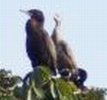I spent three days over at Veracruz, Mexico last week and thought I should share some pictures. This is a tropical forest area known as "Los Tuxtlas" near the center south of the Gulf of Mexico. We stayed at Catemaco, a town on a lake side with about 45,000 population. Mel Gibson was around making a new film.
Luis
View of the town of Catemaco from our Hotel:

View of the same town from Boat:

Hey, get off the boat!

Birds on a tree:

Don't get too close...

On our way to the Eyipantla falls:

View from the top:

Luis
View of the town of Catemaco from our Hotel:

View of the same town from Boat:

Hey, get off the boat!

Birds on a tree:

Don't get too close...

On our way to the Eyipantla falls:

View from the top:




